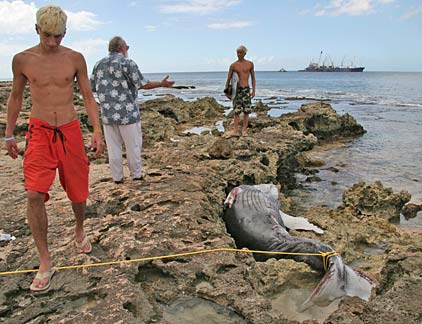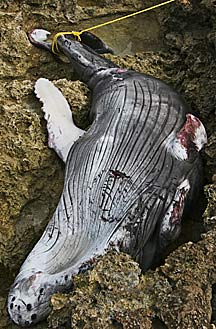
|
Biologists investigate
dead baby humpback
The newborn whale washes up
near Barbers Point Harbor
with a fin severed
The carcass of a newborn humpback whale washed ashore Tuesday evening just south of Barbers Point Harbor at Kalaeloa.
![]()

The carcass of a humpback whale calf was found near the entrance of Barbers Point Harbor.
Faris, assistant regional administrator for protected resources, also could not say whether the whale lost its fin to a boat propeller, sharks or something else. She had not heard of any recent reports of boats striking a whale.
Scientists were to perform a necropsy (animal autopsy) on the whale last night. However, Faris noted that one in five newborn humpbacks dies while in Hawaii's waters. The survivors migrate to northern Pacific waters in the spring. "That's what the mortality rate is," she said.
During the current humpback whale season in Hawaii, which began in November, some researchers have reported seeing newborn whales with their mothers, then seeing the mothers without the calves, Faris said. Since the calves depend on the mothers for milk, they are presumed dead.
However, this whale's body was the first this year to wash ashore, she said.
Scientists know that the 12-foot-long whale was born recently because there was still evidence of an umbilical cord, Faris said.
Helicopter flights in the area in the past week have spotted whales, but none have appeared close to the cargo ship Cape Flattery, which has been grounded on a coral reef since Feb. 2, said fisheries service biologist John Naughton.
"At this time we have no idea whether the whale's mortality is associated with the ship grounding or removal operation," he said.
A Coast Guard spokesman said he has had no reports of any contact with a whale during the ongoing attempts to remove cargo from the ship and refloat it.
[News] [Business] [Features] [Sports] [Editorial] [Do It Electric!]
[Classified Ads] [Search] [Subscribe] [Info] [Letter to Editor]
[Feedback]
